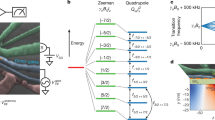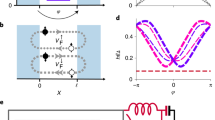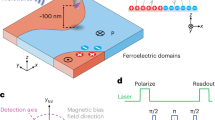Abstract
The ability to manipulate and monitor a single-electron spin using electron spin resonance is a long-sought goal. Such control would be invaluable for nanoscopic spin electronics, quantum information processing using individual electron spin qubits and magnetic resonance imaging of single molecules. There have been several examples1,2 of magnetic resonance detection of a single-electron spin in solids. Spin resonance of a nitrogen-vacancy defect centre in diamond has been detected optically3, and spin precession of a localized electron spin on a surface was detected4,5 using scanning tunnelling microscopy. Spins in semiconductors are particularly attractive for study because of their very long decoherence times6. Here we demonstrate electrical sensing of the magnetic resonance spin-flips of a single electron paramagnetic spin centre, formed by a defect in the gate oxide of a standard silicon transistor. The spin orientation is converted to electric charge, which we measure as a change in the source/drain channel current. Our set-up may facilitate the direct study of the physics of spin decoherence, and has the practical advantage of being composed of test transistors in a conventional, commercial, silicon integrated circuit. It is well known from the rich literature of magnetic resonance studies that there sometimes exist structural paramagnetic defects7 near the Si/SiO2 interface. For a small transistor, there might be only one isolated trap state that is within a tunnelling distance of the channel, and that has a charging energy close to the Fermi level.
This is a preview of subscription content, access via your institution
Access options
Subscribe to this journal
Receive 51 print issues and online access
$199.00 per year
only $3.90 per issue
Buy this article
- Purchase on Springer Link
- Instant access to full article PDF
Prices may be subject to local taxes which are calculated during checkout





Similar content being viewed by others
References
Köhler, J. et al. Magnetic resonance of a single molecular spin. Nature 363, 242–244 (1993)
Wrachtrup, J., von Borczyskowski, C., Bernard, J., Orrit, M. & Brown, R. Optical detection of magnetic resonance in a single molecule. Nature 363, 244–245 (1993)
Jelezko, F., Gaebel, T., Popa, I., Gruber, A. & Wrachtrup, J. Observation of coherent oscillations in a single electron spin. Phys. Rev. Lett. 92, 076401 (2004)
Manassen, Y., Hames, R. J., Demuth, J. E. & Castellano, A. J. Direct observation of the precession of individual paramagnetic spins on oxidized silicon surfaces. Phys. Rev. Lett. 62, 2531–2534 (1989)
Durkan, C. & Welland, M. E. Electronic spin detection in molecules using scanning-tunneling-microscopy-assisted electron-spin resonance. Appl. Phys. Lett. 80, 458–460 (2002)
Tyryshkin, A. M., Lyon, S. A., Astashkin, A. V. & Raitsimring, A. M Electron spin relaxation times of phosphorus donors in silicon. Phys. Rev. B 68, 193207 (2003)
Poindexter, E. H. in Semiconductor Interfaces, Microstructure, and Devices (ed. Feng, Z. C.) Ch. 10, 229–256 (Inst. Phys. Publ., Bristol, Philadelphia, 1993)
Loss, D. & DiVincenzo, D. P. Quantum computation with quantum dots. Phys. Rev. A. 57, 120–126 (1998)
Friesen, M. et al. Practical design and simulation of silicon-based quantum-dot qubits. Phys. Rev. B 67, 121301 (2003)
Vrijen, R. et al. Electron-spin-resonance transistors for quantum computing in silicon-germanium heterostructures. Phys Rev. A 62, 012306 (2000)
Kane, B. E. A silicon based nuclear spin quantum computer. Nature 393, 133–137 (1998)
Kirton, M. J. & Uren, M. J. Noise in solid-state microstructures: a new perspective on individual defects, interface states and low-frequency (1/f) noise. Adv. Phys. 38, 367–468 (1989)
Xiao, M., Martin, I. & Jiang, H. W. Probing the spin state of a single electron trap by random telegraph signal. Phys. Rev. Lett. 91, 078301 (2003)
Martin, I., Mozyrsky, D. & Jiang, H. W. A scheme for electrical detection of single electron spin resonance. Phys. Rev. Lett. 90, 018301 (2003)
Liu, W., Ji, Z., Pfeiffer, L., West, K. W. & Rimberg, A. J. Real-time detection of electron tunnelling in a quantum dot. Nature 423, 422–425 (2003)
Kato, Y. et al. Gigahertz electron spin manipulation using voltage-controlled g-tensor modulation. Science 299, 1201–1204 (2003)
Yablonovitch, E. et al. Optoelectronic quantum telecommunications based on spins in semiconductors. Proc. IEEE 91, 761–780 (2003)
Wallace, W. J. & Silsbee, R. Spin resonance of inversion-layer electrons in silicon. Phys. Rev. B 44, 12964–12968 (1991)
Eton, S. S. & Eaton, G. R. Irradiated fused-quartz standard sample for time-domain EPR. J. Magn. Res. Ser. A 102, 354–356 (1993)
Acknowledgements
We would like to thank P. M. Lenahan for information regarding the relaxation of spin centres in SiO2, and K. Wang for helping to secure the samples. The work was supported by the Defense Advanced Research Projects Agency and the Defense MicroElectronics Activity.
Author information
Authors and Affiliations
Corresponding author
Ethics declarations
Competing interests
The authors declare that they have no competing financial interests.
Rights and permissions
About this article
Cite this article
Xiao, M., Martin, I., Yablonovitch, E. et al. Electrical detection of the spin resonance of a single electron in a silicon field-effect transistor. Nature 430, 435–439 (2004). https://doi.org/10.1038/nature02727
Received:
Accepted:
Issue Date:
DOI: https://doi.org/10.1038/nature02727
This article is cited by
-
Improving stability in two-dimensional transistors with amorphous gate oxides by Fermi-level tuning
Nature Electronics (2022)
-
Exploiting chemistry and molecular systems for quantum information science
Nature Reviews Chemistry (2020)
-
Electron Paramagnetic Resonance of Single Magnetic Moment on a Surface
Scientific Reports (2016)
-
Passivation and characterization of charge defects in ambipolar silicon quantum dots
Scientific Reports (2016)
-
Electron spin resonance and spin–valley physics in a silicon double quantum dot
Nature Communications (2014)
Comments
By submitting a comment you agree to abide by our Terms and Community Guidelines. If you find something abusive or that does not comply with our terms or guidelines please flag it as inappropriate.



